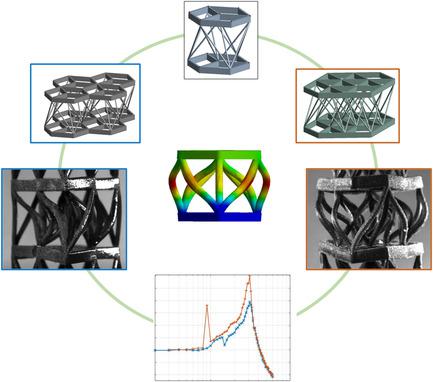当前位置:
X-MOL 学术
›
Adv. Eng. Mater.
›
论文详情
Our official English website, www.x-mol.net, welcomes your
feedback! (Note: you will need to create a separate account there.)
Tailoring the Dynamic Actuation of 3D Printed Mechanical Metamaterials through Inherent and Extrinsic Instabilities
Advanced Engineering Materials ( IF 3.4 ) Pub Date : 2020-03-24 , DOI: 10.1002/adem.201901586 Zacharias Vangelatos 1, 2 , Zhizhou Zhang 1, 3 , Grace X. Gu 1, 3 , Costas P. Grigoropoulos 1, 2
Advanced Engineering Materials ( IF 3.4 ) Pub Date : 2020-03-24 , DOI: 10.1002/adem.201901586 Zacharias Vangelatos 1, 2 , Zhizhou Zhang 1, 3 , Grace X. Gu 1, 3 , Costas P. Grigoropoulos 1, 2
Affiliation

|
Architected materials have facilitated a significant breakthrough in the control of the mechanical behavior of structures. Most notably, metamaterials with unprecedented properties can be easily designed in large scales, exhibiting high strength, tunability of their properties, resilience or versatility to large deformations, and auxetic behavior. In addition, 4D printed structures can modify their shape depending on the working environment. Due to their chemical composition, these structures can modify their mechanical and electrochemical properties based on external stimuli. This mechanism has substantial implications on the mechanical response of the material, furnishing stiffening of the structure or malleability on demand. Furthermore, designing structures that are also adaptive to actuation has given rise to the design of flexible 3D-printed mechanisms. Flexible structures can be utilized for engineering applications requiring large but recoverable deformations, continuous motion, and high precision. A characteristic category of structures encompassing these properties are soft robotics. Soft robotic mechanisms are composed of rubber materials that can be electrically actuated to sustain nonlinear deformations. Combining these designs with much stronger fiber components leads to the design of artificial muscles, imitating animal motion and having a significantly higher strength than simple soft robot systems. Nevertheless, metamaterials also exhibit remarkable properties that are not observed in conventional systems. A characteristic example is the transport of mechanical signals with the proclivity to a specific direction. This has been accomplished through the design of nonreciprocal mechanical metamaterials. In regular materials, the transmission of any physical quantity, such as mechanical signals or mechanical waves, is identical, regardless of geometrical or material asymmetries and defects between any two points in space. However, nonreciprocal metamaterials can alter this behavior, giving directionality to the transport of these mechanical quantities. This is the paragon of the next-generation mechanical signal transport, isolation, and energy storage. In addition, the combination of the architected design with the macroscopic dynamic loading conditions can provide the formation of distinct elastic vector solitons. These coupled waves can have significantly different formations depending on the direction of the wave, controlling not only the direction of the signal, but also its shape. The inexorable advances in 3D printing technology have enabled the fabrication of these structures. Techniques such as fused deposition modeling (FDM), Z. Vangelatos, Z. Zhang, Prof. G. X. Gu, Prof. C. P. Grigoropoulos Department of Mechanical Engineering University of California, Berkeley Berkeley, CA 94720, USA E-mail: zacharias_vangelatos@berkeley.edu; zz_zhang@berkeley.edu; ggu@berkeley.edu; cgrigoro@berkeley.edu Z. Vangelatos, Prof. C. P. Grigoropoulos Department of Mechanical Engineering Laser Thermal Laboratory University of California, Berkeley Berkeley, CA 94720, USA Z. Zhang, Prof. G. X. Gu Gu Research Group Department of Mechanical Engineering University of California, Berkeley Berkeley, CA 94720, USA
中文翻译:

通过固有和外部不稳定性定制 3D 打印机械超材料的动态驱动
建筑材料促进了结构力学行为控制的重大突破。最值得注意的是,具有前所未有特性的超材料可以很容易地进行大规模设计,表现出高强度、其特性的可调性、对大变形的弹性或多功能性以及拉胀行为。此外,4D 打印结构可以根据工作环境修改其形状。由于它们的化学成分,这些结构可以根据外部刺激改变它们的机械和电化学性能。这种机制对材料的机械响应具有重大影响,可根据需要提供结构的刚度或延展性。此外,设计也适用于驱动的结构催生了灵活的 3D 打印机构的设计。柔性结构可用于需要大但可恢复变形、连续运动和高精度的工程应用。包含这些特性的结构的一个特征类别是软机器人。软机器人机构由橡胶材料组成,可以通过电驱动来承受非线性变形。将这些设计与更坚固的纤维组件相结合,可以设计出人造肌肉,模仿动物运动,并且比简单的软机器人系统具有更高的强度。尽管如此,超材料也表现出在传统系统中没有观察到的显着特性。一个典型的例子是具有向特定方向倾向的机械信号的传输。这是通过非互易机械超材料的设计实现的。在常规材料中,任何物理量(例如机械信号或机械波)的传输都是相同的,无论空间中任意两点之间存在几何或材料不对称性和缺陷。然而,非互易超材料可以改变这种行为,为这些机械量的传输提供方向性。这是下一代机械信号传输、隔离和能量存储的典范。此外,将架构设计与宏观动态载荷条件相结合,可以形成不同的弹性矢量孤子。根据波的方向,这些耦合波可以具有显着不同的形式,不仅控制信号的方向,还控制其形状。3D 打印技术的不可阻挡的进步使这些结构的制造成为可能。熔融沉积建模 (FDM) 等技术,Z. Vangelatos,Z. Zhang,GX Gu 教授,CP Grigoropoulos 教授 加州大学伯克利分校机械工程系 Berkeley,CA 94720,美国 电子邮件:zacharias_vangelatos@berkeley。教育; zz_zhang@berkeley.edu; ggu@berkeley.edu; cgrigoro@berkeley.edu Z. Vangelatos, Prof. CP Grigoropoulos 机械工程系激光热实验室加州大学伯克利分校 Berkeley, CA 94720, USA Z. Zhang, Prof. GX
更新日期:2020-03-24
中文翻译:

通过固有和外部不稳定性定制 3D 打印机械超材料的动态驱动
建筑材料促进了结构力学行为控制的重大突破。最值得注意的是,具有前所未有特性的超材料可以很容易地进行大规模设计,表现出高强度、其特性的可调性、对大变形的弹性或多功能性以及拉胀行为。此外,4D 打印结构可以根据工作环境修改其形状。由于它们的化学成分,这些结构可以根据外部刺激改变它们的机械和电化学性能。这种机制对材料的机械响应具有重大影响,可根据需要提供结构的刚度或延展性。此外,设计也适用于驱动的结构催生了灵活的 3D 打印机构的设计。柔性结构可用于需要大但可恢复变形、连续运动和高精度的工程应用。包含这些特性的结构的一个特征类别是软机器人。软机器人机构由橡胶材料组成,可以通过电驱动来承受非线性变形。将这些设计与更坚固的纤维组件相结合,可以设计出人造肌肉,模仿动物运动,并且比简单的软机器人系统具有更高的强度。尽管如此,超材料也表现出在传统系统中没有观察到的显着特性。一个典型的例子是具有向特定方向倾向的机械信号的传输。这是通过非互易机械超材料的设计实现的。在常规材料中,任何物理量(例如机械信号或机械波)的传输都是相同的,无论空间中任意两点之间存在几何或材料不对称性和缺陷。然而,非互易超材料可以改变这种行为,为这些机械量的传输提供方向性。这是下一代机械信号传输、隔离和能量存储的典范。此外,将架构设计与宏观动态载荷条件相结合,可以形成不同的弹性矢量孤子。根据波的方向,这些耦合波可以具有显着不同的形式,不仅控制信号的方向,还控制其形状。3D 打印技术的不可阻挡的进步使这些结构的制造成为可能。熔融沉积建模 (FDM) 等技术,Z. Vangelatos,Z. Zhang,GX Gu 教授,CP Grigoropoulos 教授 加州大学伯克利分校机械工程系 Berkeley,CA 94720,美国 电子邮件:zacharias_vangelatos@berkeley。教育; zz_zhang@berkeley.edu; ggu@berkeley.edu; cgrigoro@berkeley.edu Z. Vangelatos, Prof. CP Grigoropoulos 机械工程系激光热实验室加州大学伯克利分校 Berkeley, CA 94720, USA Z. Zhang, Prof. GX











































 京公网安备 11010802027423号
京公网安备 11010802027423号